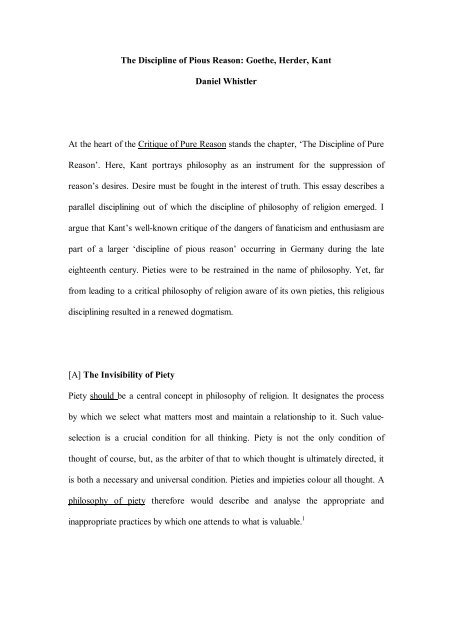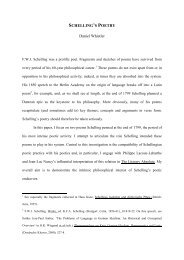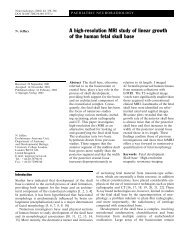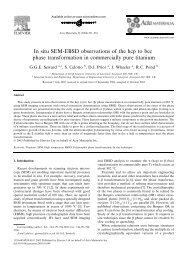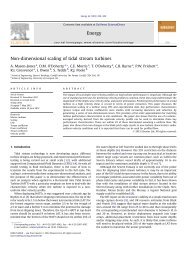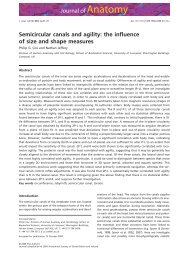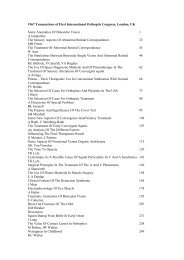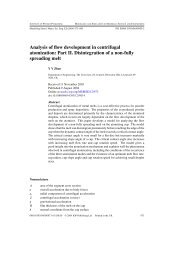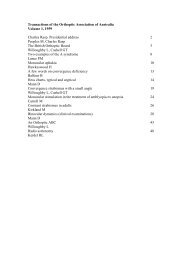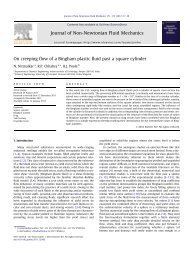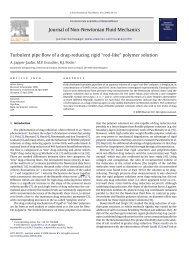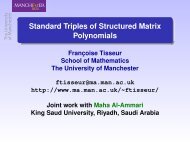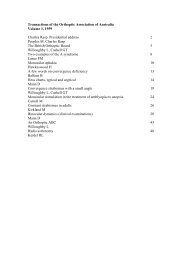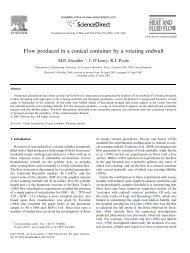The Discipline of Pious Reason: Goethe, Herder, Kant Daniel ...
The Discipline of Pious Reason: Goethe, Herder, Kant Daniel ...
The Discipline of Pious Reason: Goethe, Herder, Kant Daniel ...
You also want an ePaper? Increase the reach of your titles
YUMPU automatically turns print PDFs into web optimized ePapers that Google loves.
<strong>The</strong> <strong>Discipline</strong> <strong>of</strong> <strong>Pious</strong> <strong>Reason</strong>: <strong>Goethe</strong>, <strong>Herder</strong>, <strong>Kant</strong><br />
<strong>Daniel</strong> Whistler<br />
At the heart <strong>of</strong> the Critique <strong>of</strong> Pure <strong>Reason</strong> stands the chapter, ‘<strong>The</strong> <strong>Discipline</strong> <strong>of</strong> Pure<br />
<strong>Reason</strong>’. Here, <strong>Kant</strong> portrays philosophy as an instrument for the suppression <strong>of</strong><br />
reason’s desires. Desire must be fought in the interest <strong>of</strong> truth. This essay describes a<br />
parallel disciplining out <strong>of</strong> which the discipline <strong>of</strong> philosophy <strong>of</strong> religion emerged. I<br />
argue that <strong>Kant</strong>’s well-known critique <strong>of</strong> the dangers <strong>of</strong> fanaticism and enthusiasm are<br />
part <strong>of</strong> a larger ‘discipline <strong>of</strong> pious reason’ occurring in Germany during the late<br />
eighteenth century. Pieties were to be restrained in the name <strong>of</strong> philosophy. Yet, far<br />
from leading to a critical philosophy <strong>of</strong> religion aware <strong>of</strong> its own pieties, this religious<br />
disciplining resulted in a renewed dogmatism.<br />
[A] <strong>The</strong> Invisibility <strong>of</strong> Piety<br />
Piety should be a central concept in philosophy <strong>of</strong> religion. It designates the process<br />
by which we select what matters most and maintain a relationship to it. Such valueselection<br />
is a crucial condition for all thinking. Piety is not the only condition <strong>of</strong><br />
thought <strong>of</strong> course, but, as the arbiter <strong>of</strong> that to which thought is ultimately directed, it<br />
is both a necessary and universal condition. Pieties and impieties colour all thought. A<br />
philosophy <strong>of</strong> piety therefore would describe and analyse the appropriate and<br />
inappropriate practices by which one attends to what is valuable. 1
Nevertheless, the silence <strong>of</strong> contemporary philosophy <strong>of</strong> religion on piety is quite<br />
deafening. Piety seems to elude the critical gaze. It is for such reasons that I will<br />
speak at the end <strong>of</strong> the essay <strong>of</strong> the anti-transcendental nature <strong>of</strong> contemporary<br />
philosophy <strong>of</strong> religion; it has suppressed the conditions which made it possible. <strong>The</strong><br />
obvious question is therefore: What reasons can be given for philosophy <strong>of</strong> religion’s<br />
suppression <strong>of</strong> the conditions <strong>of</strong> its own possibility? This question structures the<br />
present essay. I ask how and why piety ‘became invisible’ and I do so by describing<br />
three ‘scenes’ from the history <strong>of</strong> ideas which take place at the intersection between<br />
philosophy <strong>of</strong> religion and moral philosophy: two early poems by <strong>Goethe</strong> (Ganymed<br />
and Prometheus) a short essay by <strong>Herder</strong> (Liebe und Selbstheit) and the closing<br />
sections <strong>of</strong> <strong>Kant</strong>’s Metaphysik der Sitten. All three dramatise the effacement <strong>of</strong> piety<br />
from philosophy <strong>of</strong> religion.<br />
In these ‘scenes’, <strong>Goethe</strong>, <strong>Herder</strong> and <strong>Kant</strong> confront the dominant pieties <strong>of</strong> their day<br />
and stutteringly articulate alternative, <strong>of</strong>ten improper models for relating to what<br />
matters most (i.e. ‘God’). All three are uneasy over how piety is usually conceived, so<br />
try to conceive it differently. <strong>The</strong> piety being challenged was essentially neoplatonic<br />
and itself had only recently come to dominance as a by-product <strong>of</strong> the Platorenaissance<br />
in post-1750 Germany. This neoplatonic piety was tethered to the figure<br />
<strong>of</strong> the One and postulated a future fusion with the divine. <strong>The</strong> impiety <strong>of</strong> <strong>Goethe</strong>,<br />
<strong>Herder</strong> and <strong>Kant</strong> focused, on the contrary, on the multiplicity <strong>of</strong> existence. This<br />
concern for multiplicity was <strong>of</strong>ten mediated (oddly enough) through Spinozist ethics.<br />
Neo-Spinozistic impiety designated the manner in which the individual relates to God<br />
as individual, released from the bonds <strong>of</strong> fusion, mysticism and apotheosis. Impieties<br />
<strong>of</strong> the multiple were pitted against pieties <strong>of</strong> the One.
More concretely, <strong>Goethe</strong>, <strong>Herder</strong> and <strong>Kant</strong> set limits to and posited restraints against<br />
the dangers posed by a neoplatonic thinking which exhibited too great a familiarity<br />
with the divine. <strong>The</strong> latter was too interested, and with such interest came the danger<br />
<strong>of</strong> being overwhelmed and ultimately engulfed by the deity. Impiety therefore took<br />
the form <strong>of</strong> an inhibition <strong>of</strong> reason, locking down its capabilities in favour <strong>of</strong> what<br />
<strong>Kant</strong> termed a pudor pietatis. Out <strong>of</strong> this restraint, philosophy <strong>of</strong> religion (or, at least,<br />
one form <strong>of</strong> it) was born. In late eighteenth century Germany, philosophy <strong>of</strong> religion<br />
was engendered as a disinterested enterprise: to philosophise one must keep one’s<br />
distance from the divine. While the philosopher is to be forever tempted by the divine,<br />
she must vigilantly thwart and frustrate such a desire. As such, she must struggle<br />
towards an improper indifference to the divine.<br />
[A] <strong>Goethe</strong>: <strong>Pious</strong> Desires and Impious Revolts<br />
I begin, then, with two <strong>of</strong> <strong>Goethe</strong>’s poems—Ganymed and Prometheus. Both written<br />
in the early 1770s, they are testament to an emergent dialectic between an attitude <strong>of</strong><br />
succumbing to the divine and one <strong>of</strong> resisting it. 2 <strong>The</strong> final stanza <strong>of</strong> Ganymed runs as<br />
follows,<br />
Hinauf! Hinauf strebt’s.<br />
Es schweben die Wolken<br />
Abwärts, die Wolken<br />
Neigen sich der sehnenden Liebe.<br />
Mir! Mir!
In euerm Schoose<br />
Aufwärts!<br />
Umfangend umfangen<br />
Aufwarts an deinen Busen,<br />
Allliebender Vater! (1919, I/2:79-80)<br />
Upwards, drawn upwards,<br />
<strong>The</strong> clouds float down,<br />
<strong>The</strong> clouds descend<br />
To my love and my longing,<br />
To me! To me!<br />
Upwards, carried in their womb,<br />
Embraced and embracing!<br />
Borne al<strong>of</strong>t to your heart,<br />
Oh father, lover <strong>of</strong> all! (2005, p. 9)<br />
Ganymed treats romantic love, love <strong>of</strong> nature and love <strong>of</strong> god. It is this last,<br />
theological level which is my present concern. Ganymede climaxes in divine love; the<br />
consummation <strong>of</strong> his existence (both its terminus and perfection) is to be absorbed<br />
back into the womb <strong>of</strong> the divine. Human desire is fulfilled in theosis. <strong>The</strong> telos <strong>of</strong><br />
individual life occurs at the moment when the god descends, humanity ascends and<br />
the two are fused together, so that all finite individuality is dissolved. Although<br />
<strong>Goethe</strong> adds romantic and pantheistic overtones, his model is therefore a traditional<br />
Christian one: blessedness is achieved by means <strong>of</strong> a dialectic <strong>of</strong> descent and ascent.<br />
God descends to Ganymede to embrace him (emptying Himself in the process), and in
that embrace human and God ascend back in glorification. <strong>The</strong>re is no moment <strong>of</strong><br />
equality.<br />
<strong>The</strong> underlying model <strong>of</strong> Ganymed can be further determined as neoplatonic; indeed,<br />
the poem bears the imprint <strong>of</strong> the neoplatonic renaissance which was spreading<br />
through Germany at this period. 3<br />
For both the <strong>Goethe</strong> <strong>of</strong> Ganymed and the<br />
neoplatonists <strong>of</strong> his day, proper human desire is desire for a return to unity with the<br />
One. It is no accident that later in his life ‘<strong>Goethe</strong> discovered in the thought <strong>of</strong><br />
Plotinus something very congenial to his own’ (Beierwaltes, 1972, p. 93). 4<br />
<strong>The</strong><br />
<strong>Goethe</strong> <strong>of</strong> Ganymed could have agreed as early as 1774 with Plotinus’ comments<br />
concerning ‘the love innate in our souls’:<br />
Every soul is an Aphrodite… As long as the soul stays true to itself, it loves the<br />
divinity and desires to be at one with it, as a daughter loves with a noble love a<br />
noble father… Only in the world beyond does the real object <strong>of</strong> our love exist, the<br />
only one with which we can unite ourselves. (1964, VI.9.9)<br />
It is important to note that <strong>Goethe</strong> conceives the One not as transcendent to the world<br />
<strong>of</strong> sense, but (in part, at least) identical with it; yet, despite this shift in emphasis, the<br />
desire to be borne ‘upwards… embraced and embracing’ remains the same. <strong>The</strong> claim<br />
that ‘love unites beings’ (<strong>Herder</strong>, 1994, 4:407; 1993, p. 111) is, as we shall see, the<br />
premise <strong>of</strong> all neoplatonic piety <strong>of</strong> the late eighteenth century.<br />
<strong>The</strong> naturalness <strong>of</strong> this desire to return to the One is a central component <strong>of</strong> the<br />
imitatio Dei and the imago Dei, both <strong>of</strong> which <strong>Goethe</strong> here flirts with. Desire for
union is the natural inclination <strong>of</strong> humanity: humanity lives to ultimately become like<br />
God. This natural inclination is also the effect <strong>of</strong> the divinity implanted in humanity<br />
from the beginning. 5 In line with this implant, the individual strives to revert back to<br />
her source and, in so doing, rise above the finite realm. For all these doctrines, fusion<br />
is the appropriate goal <strong>of</strong> human striving. <strong>The</strong> proper—or pious—relation to God is<br />
one that puts an end to all relations by merging God and humanity together into the<br />
One. In consequence, it also puts an end to all piety and to finitude altogether. This is<br />
a self-destructive form <strong>of</strong> piety. 6<br />
Contemporaneous with Ganymed, <strong>Goethe</strong> wrote the poem Prometheus. Its second<br />
stanza reads,<br />
Ich kenne nichts Ärmeres<br />
Unter der Sonn’, als euch, Götter!<br />
Ihr nähret kümmerlich<br />
Von Opfersteuern<br />
Und Gebetshauch<br />
Eure Majestät<br />
Und darbtet, wären<br />
Nicht Kinder und Bettler<br />
H<strong>of</strong>fnungsvolle Toren.<br />
I know <strong>of</strong> no poorer thing<br />
Under the sun, than you gods!<br />
Wretchedly you feed
Your own majesty<br />
On sacrificial <strong>of</strong>ferings<br />
And the breath <strong>of</strong> prayers,<br />
And you would starve<br />
If children and beggars<br />
Were not fools full <strong>of</strong> hope.<br />
<strong>The</strong> narrator (Prometheus) goes on to narrate his own childish and ‘deluded’ faith in<br />
divine mercy, before continuing later in the poem,<br />
Ich dich ehren? W<strong>of</strong>ür?<br />
Hast du die Schmerzen gelindert<br />
Je des Beladenen?<br />
Hast du die Thränen gestillet<br />
Je des Geängsteten?<br />
… Hier sitz’ ich, forme Menschen<br />
Nach meinem Bilde,<br />
Ein Geschlecht, das mir gleich sei,<br />
Zu leiden, zu weinen,<br />
Zu genießen und zu freuen sich,<br />
Und dein nicht zu achten,<br />
Wie ich! (1919, I/2:76-8)<br />
I should respect you? For what?
Have you ever soothed<br />
<strong>The</strong> pain that burdened me?<br />
Have you ever dried<br />
My terrified tears?<br />
… Here I sit, making men<br />
In my own image,<br />
A race that shall be like me,<br />
A race that shall suffer and weep<br />
And know joy and delight too,<br />
And heed you no more<br />
Than I do! (2005, pp. 11-13)<br />
While it might be slightly hyperbolic to claim with Boyle that ‘neither Nietzsche or<br />
Feuerbach will add anything <strong>of</strong> emotional or intellectual significance to this outburst<br />
<strong>of</strong> an Antichrist’ (1991, p. 164), it is certainly correct to assert that the metaphysics,<br />
theology and ethics underlying Ganymed are here rejected in their entirety.<br />
Prometheus forms a race <strong>of</strong> men in his own image—the image <strong>of</strong> revolt and<br />
autonomy. Humans are hardwired to impiety. Desire for God is transformed into<br />
desire against or despite the gods. This is what is natural to humanity: to remain selfsufficient,<br />
liberated from divine aid and divine demands. <strong>The</strong> human individual is<br />
born free <strong>of</strong> the gods—and this is something to be celebrated, since the gods are<br />
despicable creatures, feeding on sacrifice, prayer and hope only to give slavery in<br />
return. We are far away from the pious desires <strong>of</strong> Ganymed. <strong>The</strong> allure <strong>of</strong> the<br />
theological has been neutralised. If ‘philosophy <strong>of</strong> religion has no higher task than to
question dominant pieties’ (Goodchild, 2002, p. 3), then Prometheus is a crucial text<br />
in the genesis <strong>of</strong> philosophy <strong>of</strong> religion.<br />
If Ganymed is the <strong>of</strong>fspring <strong>of</strong> the neoplatonic renaissance, whence comes<br />
Prometheus? Although it might sound initially odd to modern ears, to some <strong>of</strong> its first<br />
readers <strong>Goethe</strong>’s Prometheus was a manifesto <strong>of</strong> Spinozism. Indeed, Prometheus<br />
became one <strong>of</strong> the most famous documents <strong>of</strong> late eighteenth-century neo-Spinozism,<br />
owing to the part it played in F.H. Jacobi’s 1785 Über die Lehre des Spinoza in<br />
Briefen an den Herrn Moses Mendelssohn 7 . Jacobi’s Briefe, containing a reported<br />
confession <strong>of</strong> Spinozism by G.E. Lessing, sparked the Spinozismusstreit, the<br />
repercussions <strong>of</strong> which were felt for three decades in German philosophy. Moreover,<br />
it was, Jacobi claimed, a copy <strong>of</strong> <strong>Goethe</strong>’s Prometheus which gave rise to Lessing’s<br />
admission. After Lessing praises the poem, the conversation continues (as reported by<br />
Jacobi):<br />
Lessing: I mean [Prometheus] is good in a different way… <strong>The</strong> point <strong>of</strong> view from<br />
which the poem is treated is my own point <strong>of</strong> view… <strong>The</strong> orthodox concepts <strong>of</strong><br />
the Divinity are no longer for me, I cannot stomach them. Hen kai pan! I know <strong>of</strong><br />
nothing else. That is also the direction <strong>of</strong> the poem, and I must confess I like it<br />
very much.<br />
I: <strong>The</strong>n you must be pretty well in agreement with Spinoza.<br />
Lessing: If I have to name myself after anyone, I know <strong>of</strong> nobody else. (Jacobi,<br />
1994, p. 187)
Beginning from <strong>Goethe</strong>’s Prometheus, Lessing proceeds directly to a confession <strong>of</strong><br />
his own allegiance to Spinozism. Just like <strong>Goethe</strong>, he claims, ‘I too am a disciple <strong>of</strong><br />
Spinoza.’<br />
What is strange is why Lessing should think Prometheus is obviously Spinozist or<br />
promotes in any way a Spinozist worldview. 8 Lessing’s own explanation that the hen<br />
kai pan <strong>of</strong> Spinoza’s monism is somehow implicitly present in the poem seems, on the<br />
face <strong>of</strong> it, patently false. <strong>The</strong> poem speaks <strong>of</strong> gods and is imbibed with the<br />
polytheistic worldview <strong>of</strong> the Greeks. It in no way questions the existence <strong>of</strong> these<br />
multiple divinities. 9 What Prometheus interrogates is not so much the metaphysical<br />
assumptions <strong>of</strong> theist or even polytheist worldviews, but their ethics. <strong>The</strong> gods<br />
obstruct humanity’s joyous pursuit <strong>of</strong> its earthly existence with their ressentiment;<br />
Prometheus’ stealing <strong>of</strong> the heavenly fire is a symbolic liberation from dependence on<br />
the gods—freeing humanity to increase its joy through its own activity. Prometheus<br />
allows the individual to desire as individual, free from the gods.<br />
Some <strong>of</strong> this may just about sound Spinozist; however, to those involved in the early<br />
stages <strong>of</strong> the Spinoza renaissance in 1770s and 1780s Germany (like Lessing) it was<br />
the very essence <strong>of</strong> Spinozism. It is, however, crucial to stress that the Spinozist<br />
reading is one Lessing imposes on <strong>Goethe</strong>’s text; there is no evidence that <strong>Goethe</strong> at<br />
this period subscribed to Lessing’s ‘ethical neo-Spinozism’ or intended Prometheus to<br />
be Spinozist in any way, shape or form. 10 Indeed, in 1785 he firmly reprimanded<br />
Jacobi for implicating his poetry in this controversy (1919, IV/7:212-4). What<br />
complicates the picture somewhat, however, is that in the early 1780s (around seven<br />
years after writing Prometheus) <strong>Goethe</strong> did become an important figure in the German
Spinoza revival; this is one <strong>of</strong> the reasons why, in fact, Jacobi employed <strong>Goethe</strong>’s<br />
poetry in his critique <strong>of</strong> contemporary Spinozism. However, it is important to note<br />
that, despite the fame Prometheus was to have as a manifesto <strong>of</strong> Spinozism, it was<br />
most likely not intended as such.<br />
This <strong>of</strong> course merely adds to questions why Lessing did call <strong>Goethe</strong>’s Prometheus<br />
Spinozist and hopefully this will become clearer as the essay progresses. In the<br />
meantime, we can preliminarily conclude from the initial juxtaposition <strong>of</strong> Ganymed<br />
and Prometheus that <strong>Goethe</strong>’s early poetry exhibits two distinct lines <strong>of</strong> thought: one,<br />
in line with the neoplatonic revival <strong>of</strong> his day, conceives the appropriate relation to<br />
God to reside in fusion. <strong>The</strong> other line <strong>of</strong> thought, however, contests this: Prometheus<br />
asserts the need to rebel against such a pious ethos, to keep one’s distance and remain<br />
free as human. Prometheus rebels against the all-embracing oneness <strong>of</strong> Ganymed in<br />
the name <strong>of</strong> the multiple.<br />
[A] <strong>The</strong> <strong>Herder</strong>/Hemsterhuis Debate<br />
<strong>The</strong> next ‘scene’ I explore furthers this tension between neoplatonic piety and neo-<br />
Spinozist impiety. In 1781, J.G. <strong>Herder</strong> wrote a short appendix to a 1770 work by<br />
François Hemsterhuis: Liebe und Selbstheit (Ein Nachtrag zum Briefe des Herr<br />
Hemsterhuis über das Verlangen) 11 . At issue was the monopoly neoplatonism held on<br />
the God/human relation. <strong>Herder</strong> takes Hemsterhuis (as representative <strong>of</strong> this<br />
neoplatonism) to task for advocating a self-destructive conception <strong>of</strong> piety, and in its<br />
place <strong>Herder</strong> begins to articulate an alternative, neo-Spinozist model <strong>of</strong> friendship.
[B] Hemsterhuis’ Lettre sur les désirs<br />
To begin, therefore, it is worth summarising the argument <strong>of</strong> Hemsterhuis’ Lettre sur<br />
les désirs. 12 Like all Hemsterhuis’ work, this piece consists in (what one critic has<br />
called) ‘a mixture <strong>of</strong> empiricism and Platonism’ (di Giovanni, 1994, p. 47).<br />
Hemsterhuis is very influenced by the mechanistic sensualism <strong>of</strong> his French<br />
contemporaries and his vocabulary is theirs, but beneath this empiricist terminology<br />
there resides a neoplatonic metaphysics. While, it must be admitted, Hemsterhuis’<br />
neoplatonism is crude, his work was still perfectly recognisable to his contemporaries<br />
as providing an eighteenth-century reworking <strong>of</strong> neoplatonic thought. Indeed,<br />
<strong>Herder</strong>’s Liebe und Selbstheit is exclusively concerned with Hemsterhuis’<br />
neoplatonism.<br />
At the beginning <strong>of</strong> the work, Hemsterhuis states, ‘<strong>The</strong> absolute goal <strong>of</strong> the soul,<br />
when it desires, is the most intimate and most perfect union <strong>of</strong> its own essence with<br />
that <strong>of</strong> the desired object.’ (Hemsterhuis, 1846, p. 54) Again, the comparison with<br />
Plotinus is revealing: as for Plotinus so for Hemsterhuis, to desire something is to<br />
desire to become one with it. Moreover, and also in line with Plotinus, such desire is a<br />
force <strong>of</strong> attraction inherent in all matter. A tendency towards oneness forms the<br />
essence <strong>of</strong> all beings—animate and inanimate. Whenever there is more than one<br />
discrete object dispersed in the world, the natural inclination will be to rid the world<br />
<strong>of</strong> the multiple until only the One remains. <strong>The</strong> ultimate goal <strong>of</strong> this tendency is ‘that<br />
two substances will become united to such an extent that any notion <strong>of</strong> duality will be<br />
destroyed.’ (ibid, 53) As <strong>Herder</strong> summarises, ‘Hemsterhuis demonstrated that love<br />
unites beings and that all longing, all desire, strives only for this union, as the only<br />
possible pleasure <strong>of</strong> separated beings.’ (1994, 4:408; 1993, p. 112)
<strong>The</strong> similarity to Ganymed is immediately obvious: ethics is ruled by the One. Lettre<br />
sur les désirs can be read as a theoretical elaboration <strong>of</strong> many <strong>of</strong> the philosophical and<br />
theological presuppositions behind <strong>Goethe</strong>’s poem; in fact, Hemsterhuis’ work is<br />
representative <strong>of</strong> the neoplatonic renaissance as a whole which was then sweeping<br />
Germany. 13 All ethics, even our relation to God, remains bound to the model <strong>of</strong> union.<br />
Just as in Ganymed, piety is the natural desire for all-embracing oneness.<br />
Every mental and physical event can be explained by striving for union. Much <strong>of</strong><br />
Hemsterhuis’ account here is explicitly dependent on Aristophanes and Socrates’<br />
myths <strong>of</strong> desire in the Symposium. All the physical behaviour <strong>of</strong> animate organisms is<br />
directed towards sexual union, or, as Hemsterhuis puts it, ‘all the physical means the<br />
soul has at its disposal are used in its tendency towards a union <strong>of</strong> essences’ (1846, p.<br />
58). 14 Moreover, again, following traditional Platonic thought, Hemsterhuis goes on to<br />
distinguish such sexual union from intellectual union and assigns the telos <strong>of</strong> reality to<br />
the latter. <strong>The</strong> fusion <strong>of</strong> mind and world (or, even better, mind and mind) provides the<br />
ultimate standard for all activity. It explains (among other things) art, friendship, love<br />
and religion. In fact, Hemsterhuis ranks these different phenomena on the basis <strong>of</strong><br />
their capacity for unification:<br />
One will love a beautiful statue less than one’s friend, one’s friend less than one’s<br />
mistress and one’s mistress less than the Supreme Being. It is for this reason that<br />
religion gives rise to more intense enthusiasts than love, love more than friendship<br />
and friendship more than desire for purely material things. (ibid, p. 54)
<strong>The</strong> reasoning behind this hierarchy is to be found in the maxim, ‘<strong>The</strong> degree <strong>of</strong><br />
attractive force is always measured by the degree <strong>of</strong> homogeneity to the desired<br />
object, and this degree <strong>of</strong> homogeneity consists in the degree to which perfect union is<br />
possible.’ (ibid, p. 54) <strong>The</strong> extent to which I desire an object is determined by the<br />
likely union I can achieve with it. Hence, friendship is inferior to love because the<br />
complete fusion <strong>of</strong> two beings into one is more the preserve <strong>of</strong> love than <strong>of</strong> friendship.<br />
Friendship is, on this account, merely an imperfect form <strong>of</strong> love; a less intense desire<br />
for complete union.<br />
<strong>The</strong> above also provides Hemsterhuis with the beginnings <strong>of</strong> an account <strong>of</strong> the<br />
relation between humanity and God (and so <strong>of</strong> piety). God is the being into which one<br />
can be most easily absorbed without remainder. Through religion desire can be most<br />
easily consummated; it is thus the most proper channel for human desire. Here,<br />
‘homogeneity appears perfect’ (ibid, p. 55). In consequence, religion is the very<br />
paradigm and the most natural form <strong>of</strong> human behaviour. <strong>The</strong>re is nothing more<br />
proper to humanity than fusing with God.<br />
However, Hemsterhuis ends his Lettre having hit a snag. If all tends towards<br />
‘coagulation’ (and the human/God relation is the paradigm example <strong>of</strong> this), why then<br />
do there still remain discrete, individual entities? <strong>The</strong> question, as Hemsterhuis notes,<br />
is even more problematic with respect to creation: if love is a tendency towards union<br />
and God loves his creatures infinitely, why then did He disperse them into isolated<br />
individuals when creating them? Hemsterhuis has no answer to such questions;<br />
instead, he concludes as follows,
I conclude from this that everything visible and sensible is in fact in an artificial<br />
state, since, tending eternally to union but remaining always composed <strong>of</strong> isolated<br />
individuals, the nature <strong>of</strong> everything continues to be eternally in a state <strong>of</strong><br />
contradiction… Since everything tends naturally towards unity, then there must be<br />
a foreign force who has decomposed the total unity into individuals and this force<br />
is God. It would require the most extravagant madness to want to penetrate to the<br />
essence <strong>of</strong> this impenetrable being. (ibid, p. 68)<br />
In the end, individuation remains an insoluble, divine mystery for Hemsterhuis. <strong>The</strong><br />
force <strong>of</strong> inertia which impedes the desire to unite is a surd he is unable to theorise. It<br />
belongs to the suprarational realm <strong>of</strong> the divine which human thought cannot access.<br />
[B] <strong>Herder</strong>’s Postscript<br />
<strong>Herder</strong>’s Liebe und Selbstheit picks up the thread <strong>of</strong> Hemsterhuis’ argument precisely<br />
at this point. <strong>Herder</strong> takes it upon himself to provide an answer to this mystery, a<br />
theoretical basis to the question <strong>of</strong> why there are individuals. In so doing, he ends up<br />
contesting the very neoplatonic model <strong>of</strong> piety Hemsterhuis was attempting to justify.<br />
<strong>Herder</strong>’s essay is explicitly intended as a mere ‘postscript’, filling in the gaps <strong>of</strong><br />
Hemsterhuis’ description <strong>of</strong> reality. Yet, as we know from other postscripts (such as<br />
Kierkegaard’s Concluding Unscientific Postscript), such a genre <strong>of</strong> writing not only<br />
adds to the original but tends to end up supplanting it. This is, in fact, the case here: in<br />
providing a theory <strong>of</strong> the pleasure <strong>of</strong> individual existence, <strong>Herder</strong> ultimately<br />
invalidates Hemsterhuis’ neoplatonism. <strong>Herder</strong>, that is, depicts a competing view <strong>of</strong><br />
reality—in place <strong>of</strong> Hemsterhuis’ metaphysics <strong>of</strong> the One, he describes an alternative<br />
ethics <strong>of</strong> friendship.
<strong>The</strong> crux <strong>of</strong> <strong>Herder</strong>’s disagreement is contained in the following claim,<br />
<strong>The</strong> more spiritual the pleasure, the more it endures and the more its object also<br />
endures outside <strong>of</strong> us… [the more] an object exists and continues to exist outside<br />
<strong>of</strong> us and can only really become one with us metaphorically, that is, hardly or not<br />
at all. (1994, 4:409; 1993, p. 113)<br />
Hemsterhuis asserted that desire for union (and so the possibility <strong>of</strong> union) increased<br />
the more spiritual the desire became; <strong>Herder</strong> here—under the pretext <strong>of</strong> summarising<br />
Hemsterhuis’ thought—gives a diametrically opposed analysis. <strong>The</strong> more spiritual a<br />
desire, the less explaining it by means <strong>of</strong> fusion makes sense, for such fusion is, in<br />
fact, less possible here. Moreover, in a complete disregard for Hemsterhuis’ actual<br />
position, <strong>Herder</strong> suggests this is a good thing: pious desire for union is not something<br />
to be positively valued, but is rather merely the model for ‘crude’ desires. Desire for<br />
union is a ‘brief, deceptive illusion’ (ibid, 4:416; p. 116). Spiritual desires are to be<br />
valued more highly precisely because they obey a very different model and are not<br />
determined by the figure <strong>of</strong> the One.<br />
<strong>The</strong> reason for this is the self-destructiveness <strong>of</strong> neoplatonic piety. As Aristophanes<br />
already noted in the Symposium, when one unites with the object, all pleasure is at an<br />
end, for the subject/object relation is annulled. <strong>The</strong> same problem holds for<br />
Hemsterhuis who follows the Symposium closely: desire for the One destroys desire.<br />
‘It is impossible for man to flow together with everything like mud’—and stay man,<br />
<strong>Herder</strong> writes (ibid, 4:422; p. 119). Hence, <strong>Herder</strong> argues that spiritual pleasures are
an improvement upon carnal ones precisely because there is no union and so the<br />
desired object goes on persisting. It is for this reason desires, pleasures and even ways<br />
<strong>of</strong> relating to God that do not tend towards unity are to be preferred—and at this point<br />
<strong>Herder</strong> leaves Hemsterhuis far behind him.<br />
In opposition to Hemsterhuis, <strong>Herder</strong> introduces his alternative: friendship, which will<br />
go on to become the key motif in what follows.<br />
Friendship! What a… holy bond it is! It links hearts and hands together into one<br />
common purpose… It [unlike love] is ongoing and arduous… Love destroys<br />
either itself or its object with penetrating, consuming flames, and both lover and<br />
beloved then lie there like a pile <strong>of</strong> ashes. But the fire <strong>of</strong> friendship is pure,<br />
refreshing, human warmth. (ibid, 4:410-1; pp. 113-4)<br />
In a reworking <strong>of</strong> Classical and humanist discourses on the eros/philia distinction,<br />
<strong>Herder</strong> maintains that, while love designates those desires that tend towards union,<br />
friendship is the name <strong>of</strong> another, preferable ethical relation—which does not destroy<br />
its object, but allows it to persist. In friendship, desire does not obliterate itself. <strong>The</strong><br />
crucial word is ‘ongoing’: friendship is the pleasure between individuals as<br />
individuals; unlike love, such pleasure is not premised on the ultimate dissolution <strong>of</strong><br />
the desiring subject and desired object—but on their perpetuation. Unlike love which<br />
is caught up in the self-destructive paradox that desire is for an end <strong>of</strong> desire (that, in<br />
other words, the individual desires her own dissolution), friendship maintains the<br />
integrity and distinctness <strong>of</strong> the subject and object even in the achievement <strong>of</strong>
pleasure. Friendship circumvents the One in favour <strong>of</strong> the multiple. Friendship is<br />
‘endless’—an infinite, ‘arduous’ task which never reaches completion.<br />
<strong>Herder</strong> elucidates friendship through opposing ‘common purpose’ to union. What is<br />
sought is not for two individuals to become the same, to meld into one another, but<br />
rather collaboration—the mutual and reciprocal interchange <strong>of</strong> ideas that helps form<br />
each individual in divergent ways. <strong>Herder</strong> writes, ‘<strong>The</strong> two flames on one altar play<br />
into one another, they jubilantly lift and carry one another… In general a life in<br />
common is the mark <strong>of</strong> true friendship: the disclosing and sharing <strong>of</strong> hearts’ (ibid,<br />
4:412; p. 114). Perhaps we could gloss <strong>Herder</strong>’s comments anachronistically by<br />
quoting Michèle Le Doeuff’s allusion to the collaborative relationship <strong>of</strong> John Stuart<br />
Mill and Harriet Taylor. She writes in <strong>The</strong> Sex <strong>of</strong> Knowing,<br />
However far we go back in the history <strong>of</strong> their relationship, Harriet Taylor never<br />
was a disciple <strong>of</strong> John Stuart Mill. Still less was she his creation… Each stood up<br />
to the other, neither was completely under the “influence” <strong>of</strong>, or “incorporated”<br />
by, the other, but each had to defend her/himself against the other, each had a<br />
slight tendency to want too much from the other. (Le Doeuff, 2003, p. 217)<br />
Just as for <strong>Herder</strong>, so too for Le Doeuff it is not the ‘incorporation’ <strong>of</strong> one individual<br />
into another which provides the ethical telos <strong>of</strong> life, but rather collaboration between<br />
two distinct and competing individual thinkers—not discipleship but friendship. It is<br />
the pleasure the individual as individual takes in another.
Thus, having begun with the intention <strong>of</strong> providing a mere ‘postscript’ to<br />
Hemsterhuis’ Lettre sur désirs, <strong>Herder</strong> can conclude after only two pages, ‘Even love<br />
serves friendship… Friendship appears to me to be the climax <strong>of</strong> every desire.’ (1994,<br />
4:413; 1993, pp. 114-5) In direct opposition to Hemsterhuis, instead <strong>of</strong> seeing<br />
friendship as an imperfect form <strong>of</strong> love, <strong>Herder</strong> conceives love as an imperfect form<br />
<strong>of</strong> friendship! And this is precisely because friendship is directed to other things than<br />
to union: friendship is grounded in the mutual interchange <strong>of</strong> individuals (‘this pulse<br />
<strong>of</strong> passive and active’ (ibid, 4:420; p. 118)), rather than in an illusory and unhealthy<br />
ideal <strong>of</strong> becoming-one. As <strong>Herder</strong>’s concludes,<br />
Where the destruction <strong>of</strong> the other ends there first begins a freer, more beautiful<br />
pleasure, a cheerful coexistence <strong>of</strong> many creatures who mutually seek and love<br />
one another… Consonant, not unisonant, tones must be the ones that create the<br />
melody <strong>of</strong> life and pleasure. (ibid, 4:420-1; pp. 118-9)<br />
In a matter <strong>of</strong> pages, the self-destructive piety <strong>of</strong> Hemsterhuis is thoroughly<br />
transformed into the impiety <strong>of</strong> the burgeoning philosophy <strong>of</strong> religion. Desire for<br />
fusion must be tempered by a respect for multiplicity. <strong>Discipline</strong> is privileged over<br />
consummation: what is truly ethical is that which battles against desires for union in<br />
the name <strong>of</strong> the individual will.<br />
In Liebe und Selbstheit, however, <strong>Herder</strong> is not only directing his attack outwards<br />
against Hemsterhuis, he is also interrogating his own tendencies to neoplatonic piety.<br />
Just like with <strong>Goethe</strong>, there is an internal conversation being pursued between piety<br />
and impiety. <strong>The</strong> ideal <strong>of</strong> friendship is pitched in combat against <strong>Herder</strong>’s own
attraction to a neoplatonic ethics <strong>of</strong> universal attraction. Not only are there examples<br />
from elsewhere in <strong>Herder</strong>’s work <strong>of</strong> him enthusiastically embracing this doctrine,<br />
even in Liebe und Selbstheit itself there are neoplatonic flourishes. <strong>Herder</strong><br />
apostrophises, for example,<br />
To whom can I ascend… except to you, great universal Mother, tender supreme<br />
Father!… Who ought not but to love you, for every creature draws toward you,<br />
points to you? And yet who can love you as one should, since one drowns in the<br />
sea <strong>of</strong> your thoughts and your presentient feelings and sinks into the deepest<br />
depths only beyond oneself… This eternal pull <strong>of</strong> your heart to mine is for me an<br />
innate guarantee <strong>of</strong> my eternal affection for you. (ibid, 4:417-8; p. 117)<br />
Liebe und Selbstheit is therefore not only a polemic against Hemsterhuis, but also a<br />
self-examination. Enacted within the very text <strong>of</strong> the essay is the struggle between<br />
friendship and love, impiety and piety.<br />
Hence, immediately after the above rhapsody, <strong>Herder</strong> insists, ‘Even in the current <strong>of</strong><br />
divine love, the heart remains a mere human heart.’ (ibid, 4:419; p. 117) This claim is<br />
at the centre <strong>of</strong> <strong>Herder</strong>’s interpretation <strong>of</strong> piety and, more specifically, <strong>of</strong> his attempt<br />
to apply his ethics <strong>of</strong> friendship to the human/God relation. Religion should not be<br />
directed towards a unio mystica or ascent to the divine, in which the human self is<br />
annihilated and absorbed into the Godhead. Rather, religion should insist that the<br />
individual relates to God as individual—on a purely human level, without need for<br />
apotheosis or transfiguration. ‘We always remain creatures,’ <strong>Herder</strong> insists (ibid,
4:423; p. 120). Humanity’s finitude can and should never be overcome. In relating to<br />
God, the individual must insist on remaining separate and retaining her integrity:<br />
We are individual beings, and we must be so if we do not want to give up the<br />
ground <strong>of</strong> every pleasure—our own consciousness <strong>of</strong> pleasure—and if we do not<br />
want to lose ourselves in order to find ourselves again in another being that we<br />
never are and never can be. Even if I were to lose myself in God, as mysticism<br />
strives to do, and were to lose myself in God without any further feeling or<br />
consciousness <strong>of</strong> myself, then I would no longer be experiencing pleasure. <strong>The</strong><br />
deity would have devoured me; and instead <strong>of</strong> me, the deity would have<br />
experienced the pleasure. (ibid, 4:419; p. 118)<br />
To affirm the neoplatonist notion <strong>of</strong> piety is to affirm a ‘devouring God’ who puts an<br />
end to all individual existence. It is to affirm self-destruction. Hence, instead <strong>of</strong><br />
desiring union with God, we should desire to co-exist with God and ‘peacefully and<br />
mutually seek to take pleasure in one another’ (ibid, 4:420; p. 118). We should exist<br />
autonomously and separately. <strong>The</strong> ideal is for friendship with God, rather than love <strong>of</strong><br />
God. It is the ideal for ‘the way we are in this world’ (ibid, 4:422; p. 119)—a refusal<br />
<strong>of</strong> the utopia <strong>of</strong> apotheosis in favour <strong>of</strong> continuing ethical work in the finite.<br />
Even with regard to God, therefore, humanity must achieve a ‘modulation and<br />
balance.’ (ibid, 4:420; p. 118) We will see <strong>Kant</strong> make very similar claims below.<br />
Friendship with God (as well as other finite individuals) is ‘not possible except<br />
between creatures who are mutually free and consonant, but not unisonant, let alone<br />
identical’ (ibid, 4:423; p. 120). Only by restraining our desires and holding up
alternative ideals than union can ‘the most dangerous dream’ <strong>of</strong> infinite oneness be<br />
avoided. Neoplatonic piety and the increasing engulfment <strong>of</strong> God on which it is<br />
premised should be thwarted, in favour <strong>of</strong> keeping God at a distance. Humanity<br />
should strive for an artificial and improper relation to the deity which does not<br />
succumb to natural attraction. Moreover, by means <strong>of</strong> his ethics <strong>of</strong> friendship, <strong>Herder</strong><br />
claims to have explained the mystery <strong>of</strong> individuation Hemsterhuis was unable to<br />
solve: individual existence is necessary for the experience <strong>of</strong> a different, more<br />
valuable relation than that which unification brings. Individuation is necessary for<br />
friendship, and so <strong>Herder</strong> concludes, ‘<strong>The</strong> supreme good that God could grant all<br />
creatures was and is individual existence.’ (ibid, 4:423-4; p. 120)<br />
[B] ‘Ethical Neo-Spinozism’<br />
<strong>The</strong> dispute between the superiority <strong>of</strong> friendship and love is, as I have mentioned, <strong>of</strong><br />
classical origin and was preserved in the humanist tradition. However, surprisingly, it<br />
is not on this tradition that <strong>Herder</strong> draws (at least explicitly); instead, Liebe und<br />
Selbstheit is littered with allusions to Spinoza’s Ethics. For example, <strong>Herder</strong> writes,<br />
By giving and acting, rather than receiving and being passive, our existence<br />
necessarily will become ever freer and more effective from stage to stage, our<br />
pleasure will become less damaging and destructive, and we will learn to taste<br />
ever more joy. (ibid, 4:423; p. 120)<br />
This juxtaposition <strong>of</strong> joy, activity, pleasure and freedom is extremely Spinozist. For<br />
example, Spinoza writes, ‘By joy, therefore, I shall understand… that passion by<br />
which the mind passes to a greater perfection’ (1994, IIIP11D), and by ‘greater
perfection’ Spinoza means the becoming more active <strong>of</strong> the mind (ibid, IIIP11) as<br />
well as its becoming freer (ibid, VP36). Linked here is Spinoza’s understanding <strong>of</strong><br />
conatus. When <strong>Herder</strong> exclaims, ‘You are indeed a limited, individual creature… Pull<br />
yourself together and strive on!’ (1994, 4:420; 1993, p. 118), he alludes to Spinoza’s<br />
claim that ‘the striving by which each thing strives to persevere in its being is nothing<br />
but the actual essence <strong>of</strong> the thing.’ (1994, IIIP6) Just like <strong>Herder</strong>, Spinoza conceives<br />
<strong>of</strong> individuals in terms <strong>of</strong> an endless striving; moreover, such desire is not for<br />
something that would annihilate the individual—such as fusion with or apotheosis<br />
into the divine—rather the desire is essentially finite. It is a desire to be as active and<br />
joyful as possible within the limits <strong>of</strong> finitude.<br />
However, (as with <strong>Goethe</strong>’s Prometheus) to call <strong>Herder</strong>’s model ‘Spinozist’ seems<br />
strange—for is not Spinoza the ultimate philosopher <strong>of</strong> the One, the most rigorous and<br />
extreme monist known to Western philosophy? How then can <strong>Herder</strong>’s defence <strong>of</strong> the<br />
multiple against the One be characterised as Spinozist? <strong>Herder</strong>, I seem to be arguing,<br />
is using Spinoza to argue against monism. Moreover, it is clear that <strong>Herder</strong> is<br />
unconcerned with historical and philosophical accuracy here. For example, the<br />
implicit contrast he establishes between Spinozism and neoplatonism, while plausible<br />
in some respects, cannot be maintained as sharply as he intends. Second, to align<br />
Spinoza with an ethics <strong>of</strong> friendship in opposition to an ethics <strong>of</strong> love is once more<br />
puzzling: since love (especially ‘the intellectual love <strong>of</strong> God’) plays a crucial role in<br />
the latter parts <strong>of</strong> the Ethics, while the concept <strong>of</strong> friendship does not (1994, IIIP59S,<br />
IVP37S1). <strong>Herder</strong>’s Spinoza is therefore inaccurate; indeed, ‘Spinoza’ is little more<br />
than the name <strong>of</strong> a ‘heretic’ whose attack on Orthodoxy <strong>Herder</strong> is here repeating (on a<br />
smaller scale). Spinoza is an ideological ally in the destruction <strong>of</strong> traditional
neoplatonic forms <strong>of</strong> piety and the establishment <strong>of</strong> a new, modern alternative based<br />
on autonomy, separation and ultimately indifference towards the divine.<br />
To comprehend this ‘ideological’ employment <strong>of</strong> Spinoza, we must turn to the context<br />
<strong>of</strong> Liebe und Selbstheit—a burgeoning ‘ethical neo-Spinozism’ in 1770s and early<br />
1780s Germany. <strong>The</strong>re were a number <strong>of</strong> German thinkers at this period (including<br />
<strong>Herder</strong> and Lessing) who took part in a recovery <strong>of</strong> Spinoza’s thought, but did so by<br />
‘reading the Ethics back-to-front’. Instead <strong>of</strong> concentrating on Parts I and II <strong>of</strong> the<br />
Ethics with their stress on metaphysics and the ultimate unity <strong>of</strong> all reality, this<br />
‘ethical neo-Spinozism’ sought to reinvent Spinozism by appropriating insights from<br />
the latter parts <strong>of</strong> the work on human desires and emotions. Avoiding Spinoza’s<br />
pantheism, these thinkers were far more interested in his accounts <strong>of</strong> conatus and<br />
joyful passions.<br />
<strong>The</strong>refore, prior to the pantheism controversy in 1785—when Jacobi published his<br />
Briefe and so when Spinoza-reception went mainstream—there was a period in which<br />
Spinoza was used as a resource for moral philosophy. 15 During the 1770s and early<br />
1780s, <strong>Herder</strong> frequently makes clear his adherence to the later portions <strong>of</strong> the Ethics.<br />
For example, he writes,<br />
Without doubt Spinoza was no Christian and no enthusiast. But take the purely<br />
ethical part <strong>of</strong> his Ethics, quite separately from his metaphysics, and see… in the<br />
simplest and most powerful way [Christian ethics] confirmed by facts, and<br />
grounded in its whole design. (Quoted in Bell, 1984, p. 55)
Or again, J.G. Müller reports the following conversation that took place between him<br />
and <strong>Herder</strong> in 1781:<br />
We talked <strong>of</strong> Spinoza… <strong>The</strong> first, theoretical part was, [<strong>Herder</strong>] said, the heretical<br />
one, but the second, ethical part contained the purest, most sublime ethic. (Quoted<br />
in Bell, 1984, p. 67)<br />
Prior to 1785 therefore the German Spinoza-reception is dominated by ethics—<br />
concentrating on Spinoza’s doctrines <strong>of</strong> conatus, joyful passion and freedom, at the<br />
expense <strong>of</strong> his monism. During this initial phase, the Ethics are read back-to-front. It<br />
is only in 1785 that Spinoza’s metaphysics and pantheism becomes a major issue in<br />
German thought. Indeed, Jacobi’s Briefe, which single-handedly made Spinozist<br />
metaphysics so contentious, is (amongst other things) an attack on <strong>Herder</strong>’s ‘ethical<br />
neo-Spinozism’.<br />
[B] <strong>The</strong> Neoplatonic Renaissance<br />
<strong>The</strong> argument <strong>of</strong> this essay necessitates a further claim: ‘ethical neo-Spinozism’ was<br />
generated in reaction to another more prominent renaissance <strong>of</strong> the time—a revival <strong>of</strong><br />
neoplatonic philosophy. That is, while a renewed interest in Spinoza was, it is true,<br />
characteristic <strong>of</strong> German thought in the 1770s and 1780s, even more noticeable is the<br />
significance neoplatonism took on during that period. Indeed, <strong>Herder</strong> himself was<br />
pr<strong>of</strong>oundly influenced by both movements and, as such, his work <strong>of</strong> this period bears<br />
the scars <strong>of</strong> the struggle between these two competing renaissances.
Let me flesh this out by returning to François Hemsterhuis and his context.<br />
Hemsterhuis was the leading thinker <strong>of</strong> the ‘Münster circle’—a group <strong>of</strong> mystics and<br />
theologically-inclined thinkers residing in Münster on the patronage <strong>of</strong> the Princess<br />
Gallitzen. ‘A neoplatonist in the tradition <strong>of</strong> the Cambridge Platonists and<br />
Shaftesbury’ (Gusdorf, 1976, p. 280), Hemsterhuis’ blend <strong>of</strong> empiricism and<br />
neoplatonism became representative <strong>of</strong> this group’s work. <strong>The</strong> circle was particularly<br />
influential during the late eighteenth century: Hamann moved to Münster in the last<br />
year <strong>of</strong> his life to participate in the group, Jacobi was also closely involved and<br />
<strong>Goethe</strong> and <strong>Herder</strong> were regular visitors. 16 As late as the 1790s, Novalis claimed<br />
Hemsterhuis as his favourite philosopher and devoted a ‘study’ to his work (1988,<br />
2:360-78). Indeed, Gusdorf has concluded, ‘Through the intermediary <strong>of</strong> Jacobi<br />
[among others], Hemsterhuis’ influence spread to Lessing, <strong>Herder</strong>, <strong>Goethe</strong>, Schiller<br />
and the young Romantics.’ (1976, p. 281)<br />
Hemsterhuis’ legacy was so great, I contend, precisely because his neoplatonism<br />
chimed in so well with the intellectual currents <strong>of</strong> the time. As Arthur Lovejoy has<br />
claimed, ‘a revival <strong>of</strong> the direct influence <strong>of</strong> neoplatonism was one <strong>of</strong> the conspicuous<br />
phenomena <strong>of</strong> German thought in the 1790s’ (1936, pp. 297-8) 17 ; however, this<br />
revival should be antedated by at least thirty years. Beiser, for example, has shown<br />
how the German reception <strong>of</strong> Plato began in the 1750s:<br />
It was in 1757 that Winckelmann read Plato who became one <strong>of</strong> the central<br />
influences on his aesthetics. By the 1760s interest in Plato had grown enormously.<br />
<strong>The</strong> writings <strong>of</strong> Rousseau and Shaftesbury, which were filled with Platonic<br />
themes, began to have their impact. It was also in the 1760s that Hamann, <strong>Herder</strong>,
Winckelmann, Wieland and Mendelssohn all wrote about Plato or Platonic<br />
themes. By the 1770s Plato had become a popular author. New editions and<br />
translations <strong>of</strong> his writings frequently appeared. (2002, p. 365)<br />
Bearing this context in mind, <strong>Herder</strong>’s Liebe und Selbstheit provides a fascinating<br />
microcosm <strong>of</strong> the times. In it, burgeoning ‘ethical neo-Spinozism’ is pitched in battle<br />
against the far more established neoplatonic renaissance. In this text, what is more, it<br />
becomes clear precisely why <strong>Herder</strong> rejects the prevalent neoplatonism interpretation<br />
<strong>of</strong> piety. It is because it could not account for the desire the individual experiences as<br />
an individual. Instead, the neoplatonism <strong>of</strong> the time merely saw individual existence<br />
as a transitory epiphenomenon <strong>of</strong> the One. Neoplatonic piety was self-destructive.<br />
<strong>Herder</strong> uses Spinoza to ground an ethics <strong>of</strong> the multiple so as to resolutely counter<br />
such neoplatonism. He uses Spinoza to sketch the ethical figure <strong>of</strong> ‘the not-One’ in<br />
which the mutual interchange <strong>of</strong> discrete individuals is the telos <strong>of</strong> life. He moves<br />
therefore towards a very different mode <strong>of</strong> piety. <strong>Herder</strong>’s Liebe und Selbstheit stages<br />
the ethical conflict <strong>of</strong> the period between love and friendship, between Plato and<br />
Spinoza. 18<br />
[A] <strong>Kant</strong>ian Pudor Pietatis<br />
<strong>Kant</strong>’s late philosophy—despite the notoriety <strong>of</strong> the pantheist controversy—takes<br />
place in a very different context. As he admitted when the controversy broke out, he<br />
had never really read Spinoza’s Ethics. It would be futile then to wish to discover<br />
Spinozist elements in his thought. However, despite this lack <strong>of</strong> direct influence, there<br />
are very interesting parallels between what <strong>Kant</strong> says about friendship and the
human/God relation in the Metaphysik der Sitten and ‘ethical neo-Spinozism’. <strong>Kant</strong><br />
too attacks the prevalent self-destructive piety preserved in neoplatonic thought in<br />
favour <strong>of</strong> an alternative based on friendship. What is more, <strong>Kant</strong> stresses that the<br />
disinterested quality <strong>of</strong> this alternative; he insists that his new form <strong>of</strong> piety keeps its<br />
distance from God.<br />
Indeed, the parallels between <strong>Herder</strong> and <strong>Kant</strong>’s alternative become even more<br />
noteworthy if one bears in mind, what Blumenberg has dubbed, the ‘late anti-<br />
Platonism’ <strong>of</strong> <strong>Kant</strong>’s thought (1987, p. 56). <strong>Kant</strong>’s 1796 essay, On a Recently<br />
Prominent Tone <strong>of</strong> Superiority in Philosophy, is evidence <strong>of</strong> this. It responds to the<br />
ever more prominent neoplatonic renaissance <strong>of</strong> late eighteenth century Germany, and<br />
berates ‘the new Platonists’ and their ‘latest mystico-Platonic idiom’ (2002, 8:399). 19<br />
Directly, <strong>Kant</strong> is reacting to J.G. Schlosser and F.L. Stolberg, yet, more generally, this<br />
work is a ‘polemic against a contemporary neoplatonism’ (Blumenberg, 1987, p. 53),<br />
a reaction against the neoplatonic renaissance in general. Like <strong>Herder</strong> and <strong>Goethe</strong><br />
before him, <strong>Kant</strong> is uneasy with his era’s increasing use <strong>of</strong> neoplatonic philosophy<br />
and turns on it.<br />
While the concerns <strong>of</strong> On a Recently Prominent Tone are for the most part<br />
epistemological, this turn away from Plato is also prevalent (if implicit) in the<br />
Metaphysik der Sitten and other late ethical writings. It results in an obsessive<br />
concern for limits—especially limits on love and piety. Moreover, it also results in an<br />
alternative model for ethics based on friendship.<br />
[B] <strong>The</strong> Trouble with Love
In the lectures <strong>Kant</strong> gave on the Metaphysik der Sitten, he introduces the concept <strong>of</strong><br />
pudor pietatis (modesty <strong>of</strong> piety), and this idea <strong>of</strong> limiting one’s piety or love is a<br />
central refrain throughout the lecture course. For example, the final section devoted to<br />
‘Duties to God’ is shot through with the rhetoric <strong>of</strong> discipline. Its focus is the<br />
appropriate methods for the veneration <strong>of</strong> God: on the one hand, <strong>Kant</strong> insists, ‘Love<br />
towards God is the foundation <strong>of</strong> all inner religion’ (1997, 27:720); yet, he is equally<br />
insistent that such love must be understood in an extremely attenuated fashion:<br />
Love <strong>of</strong> God can be known only through our reason… <strong>The</strong>re can be no sensuous<br />
feeling <strong>of</strong> love without a concurrent pathological effect; to love practically means<br />
merely to perform one’s actions from duty… Love God tells us no more than to<br />
base our observance <strong>of</strong> laws, not merely on obedience, which produces the<br />
coercion and necessitation <strong>of</strong> the law, but on an inclination in conformity with<br />
what the law prescribes. (ibid, 27:721)<br />
While not the main focus <strong>of</strong> <strong>Kant</strong>’s attack (the Pietists <strong>of</strong> his youth probably hold that<br />
honour), contemporary neoplatonists like Hemsterhuis are implicitly condemned here.<br />
<strong>Kant</strong>ian love <strong>of</strong> God should not be confused with a desire—either sensible or<br />
intellectual—for increasing unity with the deity; rather, ‘love’ is diluted so as to<br />
‘mean merely’ a willing performance <strong>of</strong> duty. <strong>Kant</strong> goes on to distance his own<br />
interpretation <strong>of</strong> love from ‘enthusiastic’ conceptions <strong>of</strong> ‘fanatical love’ or ‘the claim<br />
to an immediate, intercourse, fellowship and social connection with God.’ (ibid,<br />
27:726) Love must be freed from its dependence on desire, especially carnal or<br />
natural desire. Only desireless love—love which thwarts our pious temptation to<br />
approach God—is moral. A new piety is here in the process <strong>of</strong> emerging, a piety
concerned with disciplining desire and becoming disinterested about God.<br />
Indifference replaces interest as the motivating theoretical force.<br />
Moreover, such restrictions on love <strong>of</strong> the divine lead also to limitations on piety<br />
itself, for <strong>Kant</strong>, like <strong>Herder</strong> and <strong>Goethe</strong> before him, identifies piety with a constant<br />
desire for union with God and a consequent withdrawal from the finite. <strong>Kant</strong> therefore<br />
makes clear, in opposition to all ‘religious fanatics’: ‘In practising religious we do<br />
not… find ourselves in a state <strong>of</strong> devotion, i.e. in a mood directed to the immediate<br />
contemplation <strong>of</strong> God, and withdrawn from all sensible objects.’ (ibid, 27:731)<br />
Fanaticism involves a withdrawal from the world, an attempt to live on a divine plane<br />
instead <strong>of</strong> a human one. Such fanaticism, <strong>Kant</strong> continues, runs the risk <strong>of</strong> bigotry and<br />
hypocrisy, for there is no means <strong>of</strong> distinguishing genuine and fake mystic<br />
experience. In all these problematic forms <strong>of</strong> religious display, there is ‘an ostentatio<br />
pietatis’, a shameless display <strong>of</strong> religious feeling. On the other hand, <strong>Kant</strong><br />
recommends a ‘pudor pietatis which consists in a bashfulness about avoiding in one’s<br />
actions any suspicion <strong>of</strong> bigotry.’ (ibid, 27:732) Religion consists not in the<br />
cultivation <strong>of</strong> piety, but instead in restraint <strong>of</strong> piety, the limitation <strong>of</strong> desire for God<br />
and <strong>of</strong> any ‘delusion’ concerning humanity’s ability to fuse with Him. 20<br />
<strong>Kant</strong> makes a similar point in the Religion. He berates the individual who believes<br />
that ‘to become a better human being… [he must] busy himself with piety (which is a<br />
passive respect <strong>of</strong> the divine law) rather than with virtue (which is the deployment <strong>of</strong><br />
one’s forces in the observance <strong>of</strong> the duty which he respects).’ Instead, <strong>Kant</strong> advises,<br />
‘It is this virtue, combined with piety, which alone can constitute the idea we<br />
understand by the word divine blessedness (true religious disposition).’ (1998, 6:201)
<strong>Kant</strong> here almost falls into contradiction: the correct religious disposition and so the<br />
way to achieve divine blessedness is not through piety! Piety is not the appropriate<br />
manner in which to relate to God; instead, it should take a role subordinate to the<br />
cultivation <strong>of</strong> virtue and only then is the ‘true religious disposition’ attained.<br />
Blessedness is not reached by means <strong>of</strong> piety alone.<br />
<strong>Kant</strong>’s central objection is the passivity <strong>of</strong> piety. Just like Ganymede, the pious<br />
individual waits expectantly to be embraced by the divine, whereas the virtuous<br />
individual is like Prometheus actively pursuing the ends dictated by human reason—<br />
not in the hope <strong>of</strong> some future apotheosis, but with the goal <strong>of</strong> living ethically in this<br />
world. <strong>The</strong> enthusiast, who expects a future fusion into the divine and escape from<br />
this world, renounces virtue. Eschatology here trumps ethics. 21<br />
[B] Friendship beyond Love<br />
In the published Metaphysik der Sitten itself, <strong>Kant</strong> goes even further—albeit<br />
implicitly. Friendship is here crowned as the ethical ideal in a manner extremely<br />
reminiscent <strong>of</strong> <strong>Herder</strong>’s reaction to Hemsterhuis’ neoplatonism. 22 <strong>The</strong> Metaphysik der<br />
Sitten concludes with the highest form <strong>of</strong> relation that can exist between two subjects,<br />
and, <strong>Kant</strong> makes clear, this is not love but friendship. Friendship is the ideal for<br />
intersubjective relations. Just like <strong>Herder</strong>, <strong>Kant</strong> reverses the traditional neoplatonic<br />
hierarchy to assert friendship as a higher form <strong>of</strong> ethical relation than love.<br />
Friendship, <strong>Kant</strong> insists time and again, checks and frustrates love. That is, <strong>Kant</strong>—<br />
following the neoplatonists—explicitly conceives love as a desire for union, but<br />
insists that ‘respect’ is a necessary supplement in order to limit such unity. <strong>The</strong><br />
neoplatonic ideal <strong>of</strong> two subjects fusing together in love is explicitly rejected by <strong>Kant</strong>
in favour <strong>of</strong> a more temperate balance between unity and separation which he labels<br />
‘friendship’.<br />
<strong>The</strong>re are three fundamental reasons <strong>Kant</strong> prefers friendship to love. First, friendship,<br />
unlike love, is necessarily reciprocal: ‘<strong>The</strong>re can be amor unilateralis; but strictly such<br />
well-wishing changes into friendship (amicitia) through a reciprocal love, or amor<br />
bilateralis.’ (1997, 27:676) Second, friendship, unlike love, requires equality between<br />
the parties: ‘inter superiors et inferiors no friendship occurs’ (ibid, 27:676), for<br />
friendship demands ‘reciprocal esteem… among equals’ (ibid, 27:680). Finally, and<br />
here <strong>Kant</strong> is most insistent, friendship, unlike love, keeps the other at a distance. He<br />
writes in the Lectures, we ‘cannot permit the other to come too close… In this lies the<br />
mutual restriction <strong>of</strong> reciprocal love among friends.’ (ibid, 27:682) In consequence,<br />
one <strong>of</strong> <strong>Kant</strong>’s ‘rules <strong>of</strong> prudence’ reads, ‘To keep sufficiently at a distance from our<br />
friend’ so as to prevents ‘rash communication and… unrestrained love’, for ‘Too deep<br />
an intimacy detracts from worth’ (ibid, 27:684-5). <strong>Kant</strong> returns to this topic in the<br />
published version <strong>of</strong> the Metaphysik der Sitten. <strong>The</strong>re he writes,<br />
Love can be regarded as attraction and respect as repulsion, and if the principle <strong>of</strong><br />
love bids friends draw closer, the principle <strong>of</strong> respect requires them to stay at a<br />
proper distance from each other. This limitation on intimacy, which is expressed<br />
in the rule that even the best <strong>of</strong> friends should not make themselves too familiar<br />
with each other, contains a maxim that holds [in all cases]. (1996, 6:470)
<strong>The</strong> other must always be kept at their proper distance; pious fusion in love is to be<br />
avoided in favour <strong>of</strong> a relation <strong>of</strong> friendship in which the subject works at maintaining<br />
a barrier between her and her friends.<br />
<strong>Kant</strong> therefore stresses the artificial nature <strong>of</strong> friendship. While love ‘already lies in<br />
human nature’, friendship ‘is not a natural inclination’ but a task (1997, 27:682). Love<br />
and piety might be natural to humanity, but pudor pietatis and the restraint <strong>of</strong> love<br />
require work—they involve an unnatural, forced operation on ourselves. This, indeed,<br />
adds to their ethical value for <strong>Kant</strong>. 23 <strong>The</strong> artificiality <strong>of</strong> impiety is necessary to avoid<br />
the natural lure <strong>of</strong> the neoplatonic One. And <strong>of</strong> course the religious implications <strong>of</strong><br />
such a move must always be kept in mind: our desire for God and for apotheosis must<br />
be suppressed. Only friendship with God safeguards the requisite pudor pietatis.<br />
This aspect <strong>of</strong> <strong>Kant</strong>’s ethics obeys a model parallel to that which guides <strong>Kant</strong>ian<br />
philosophy as a whole: we must thwart and frustrate our natural desires in order to do<br />
good philosophy. <strong>Reason</strong> may desire to illegitimately transcend the realm <strong>of</strong> possible<br />
experience, but it is the task <strong>of</strong> the philosopher to restrain such natural desires. Just as<br />
neoplatonic piety disregards the integrity <strong>of</strong> the individual, metaphysical reason<br />
‘tear[s] down all those boundary-fences and… seize[s] possession <strong>of</strong> an entirely new<br />
domain which recognises no limits <strong>of</strong> demarcation.’ (1929, A296/B352) Such<br />
unrelenting transcendence is ‘the natural predisposition <strong>of</strong> our reason’ (2001, 4:353)<br />
which the philosopher must labour tirelessly at frustrating through conceptual work.<br />
<strong>Reason</strong> must be kept dissatisfied. 24<br />
<strong>The</strong> God/human ethical relation is one more<br />
example <strong>of</strong> this same model—a pudor pietatis. Both theoretically and ethically, the<br />
human individual requires ‘discipline’— ‘a system <strong>of</strong> precautions and self-
examination… by which the constant tendency to disobey certain rules is restrained<br />
and finally extirpated.’ (1929, A709-11/B737-9) In fact, in On a Recently Prominent<br />
Tone, <strong>Kant</strong> goes so far as to speak <strong>of</strong> ‘the police in the kingdom <strong>of</strong> the sciences’ who<br />
regulate ‘the philosopher <strong>of</strong> vision’ (2002, 8:403-4).<br />
<strong>Reason</strong>’s ethical demand is to thwart the desire so natural to humanity to fuse with the<br />
deity and so put an end to individual life. God must be held ethically at the same<br />
distance that the noumenal is theoretically. Only through restraint and ‘bashfulness’<br />
can good philosophy and correct living occur. Such is <strong>Kant</strong>’s anti-Platonic ethics.<br />
[A] A Genealogy <strong>of</strong> Piety<br />
In this essay, I have brought together three ‘scenes’ from the interface <strong>of</strong> moral<br />
philosophy and philosophy <strong>of</strong> religion which all originate from late eighteenthcentury<br />
Germany and are all concerned with developing alternatives to dominant<br />
neoplatonic conceptions <strong>of</strong> self-destructive piety. <strong>The</strong>y are not identical by any<br />
means 25 , yet all three do illustrate a similar transition. In this final, concluding section,<br />
I now want to place this description within a larger theoretical framework. It is here<br />
that I finally answer the question I posed in my Introduction: why has contemporary<br />
philosophy <strong>of</strong> religion forgotten piety?<br />
<strong>The</strong>re is no doubting the current hostility to <strong>Kant</strong> among analytic philosophers <strong>of</strong><br />
religion. 26 As a result, bold metaphysical truths are articulated without due attention to<br />
the philosophical conditions underlying them. Contemporary philosophy <strong>of</strong> religion<br />
names God, the afterlife and theological dogmas, but neglects that which makes such
naming possible. 27 This is not a new trend, however. Indeed, what I have implicitly<br />
argued in this essay is that such hostility to criticism (in the <strong>Kant</strong>ian sense) within<br />
philosophy <strong>of</strong> religion has a long historical tradition reaching back to the late<br />
eighteenth century. It is a tradition that features <strong>Kant</strong> himself! <strong>Kant</strong>’s philosophy <strong>of</strong><br />
piety (along with <strong>Herder</strong> and <strong>Goethe</strong>’s) is anti-transcendental—a philosophy <strong>of</strong> piety<br />
that reverts to dogmatism in order to combat its opponents. <strong>The</strong> dogmatism <strong>of</strong> the<br />
analytic theology movement is merely the culmination <strong>of</strong> this tradition.<br />
<strong>Goethe</strong>, <strong>Herder</strong> and <strong>Kant</strong> all attack neoplatonic piety on the grounds that it gives into<br />
its desire for God. On the contrary, they argue, this desire must be thwarted.<br />
Philosophy <strong>of</strong> religion needs to be a disinterested enterprise, exhibiting indifference to<br />
the divine. God must keep his distance. Yet, the problem with such a move is that it<br />
forecloses self-examination. Disinterest in God is disinterest in piety itself. <strong>The</strong><br />
condition on which philosophy <strong>of</strong> religion emerges as a disinterested discipline is<br />
suppressed in the very act <strong>of</strong> self-constitution. <strong>The</strong>refore, <strong>Goethe</strong>, <strong>Herder</strong> and <strong>Kant</strong><br />
inaugurate a form <strong>of</strong> philosophy <strong>of</strong> religion that neglects its own conditions. <strong>The</strong>y<br />
formulate a new piety <strong>of</strong> thought which prohibits any talk <strong>of</strong> piety. Philosophy <strong>of</strong><br />
religion here takes on dogmatic form.<br />
I want to explore this twist further in terms drawn from Philip Goodchild’s genealogy<br />
<strong>of</strong> piety. 28 Among the many lines <strong>of</strong> thought running through Goodchild’s Capitalism<br />
and Religion, one charts piety’s disappearance from philosophical scrutiny. 29 Why has<br />
modern reason effaced its own pieties? <strong>The</strong> answer concerns the nature <strong>of</strong> these<br />
pieties. <strong>The</strong>re are two: to the question, ‘what is the appropriate way to relate to God?’,<br />
one type <strong>of</strong> piety responds: ‘God is to be approached and fused with’; while the other
esponds: ‘God must be held at a distance’. Thought must either possess God or exalt<br />
Him from afar. <strong>The</strong>se two poles exist in a dialectic which circles between yielding to<br />
the desire to fuse with God and cultivating a will which thwarts such desire. Desire<br />
must be both satisfied and unsatisfied. What is crucial is that both moments (despite<br />
their antithetical relation) have an identical result—the suppression <strong>of</strong> piety. Both<br />
pieties put paid to any further critical discussion <strong>of</strong> piety as a concept. It is here we<br />
have the reason for philosophy <strong>of</strong> religion’s silence on this issue and in consequence<br />
the reason for its incessant dogmatism.<br />
This ‘dialectic’ is <strong>of</strong> course just an abstract summary <strong>of</strong> the transitions involved in the<br />
three ‘scenes’ I have described in this essay. On the one hand, piety is a desire for<br />
God. Such is the fundamental principle <strong>of</strong> the neoplatonic piety against which <strong>Goethe</strong>,<br />
<strong>Herder</strong> and <strong>Kant</strong> were reacting. Moreover, they attacked it because it is selfdestructive:<br />
piety is itself destroyed as soon as God is obtained. It obeys the logic <strong>of</strong><br />
desire elucidated by Aristophanes in Plato’s Symposium—the fulfilment <strong>of</strong> desire is<br />
the end <strong>of</strong> desire. Goodchild writes similarly,<br />
<strong>The</strong> <strong>of</strong>fence <strong>of</strong> piety that claims to identify its divinity, whether through ascending<br />
to heaven, or by the divinity ascending to earth, is that it abolishes the temporal<br />
existence <strong>of</strong> piety, and, with it, piety itself. (2002, p. 7)<br />
In the beatific vision, piety becomes redundant to itself. On this view, the goal <strong>of</strong><br />
philosophy is the elimination <strong>of</strong> all talk about piety, for once the desire on which<br />
philosophy is founded (fusion with God) is achieved, a critical philosophy <strong>of</strong> piety is
unnecessary. Dogmatic philosophy <strong>of</strong> religion is the end to which such philosophy<br />
strives.<br />
On the basis <strong>of</strong> this failure, piety is transformed, and such a transformation is<br />
precisely what I have been describing in detail in this essay. <strong>Goethe</strong>, <strong>Herder</strong> and <strong>Kant</strong><br />
react against self-destructive piety and establish another, alternative (im)piety in its<br />
place. This is the second moment <strong>of</strong> the dialectic. Now, desire becomes something to<br />
be thwarted and infinitely deferred. Philosophies form ‘defences and shields against<br />
the absolute’ (Goodchild, 2002, p. 13)—sites <strong>of</strong> discipline and restraint. Crucially,<br />
however, here too piety disappears. By thwarting desire for God, piety neutralises its<br />
own efficacy—becoming indifferent to itself. This conception <strong>of</strong> piety is therefore<br />
self-neutralising: piety is conceived in a manner which invalidates all talk <strong>of</strong> piety.<br />
Again, therefore, philosophy is told to ignore the conditions which made it possible.<br />
This anti-transcendentalism marks <strong>Goethe</strong>, <strong>Herder</strong> and <strong>Kant</strong>’s philosophies <strong>of</strong><br />
religion. <strong>The</strong> pieties underlying philosophy are not worthy <strong>of</strong> the philosopher’s<br />
disinterested gaze. Philosophy is disciplined to be dogmatic.<br />
This transition from self-destructive to disinterested piety is intimately bound up,<br />
moreover, with the genesis <strong>of</strong> philosophy <strong>of</strong> religion. Philosophy established itself as<br />
a discipline (in both senses <strong>of</strong> the word) through remaining disinterested in its own<br />
piety. <strong>Goethe</strong>, <strong>Herder</strong> and <strong>Kant</strong> enact this anti-transcendental turn in modern<br />
philosophy <strong>of</strong> religion. While neoplatonic philosophy postulated the suppression <strong>of</strong><br />
the conditions <strong>of</strong> its existence as a future ideal, <strong>Goethe</strong>, <strong>Herder</strong> and <strong>Kant</strong>’s<br />
philosophies <strong>of</strong> piety posited such suppression as an urgent necessity. Piety—as one
<strong>of</strong> the transcendental conditions <strong>of</strong> thinking—became (even more) invisible; it<br />
disappeared from the critical gaze.<br />
Ins<strong>of</strong>ar therefore as both neoplatonic and neo-Spinozist pieties fail to grasp their own<br />
transcendental conditions, neither the modern nor the premodern succeeds. Piety is<br />
caught in a vicious circle between self-destruction and self-neutralisation. Both pieties<br />
annul themselves; both moments remain complicit in philosophy’s silence about<br />
piety. It is thanks to both these traditions that philosophy <strong>of</strong> religion is still dogmatic<br />
and awaits its Copernican Revolution.<br />
What is needed therefore is a genuinely critical philosophy <strong>of</strong> religion. If, as Johnson<br />
(2010, pp. 377-8) has recently argued, the philosopher <strong>of</strong> religion should attend to ‘the<br />
conditions <strong>of</strong> naming’ what matters most (rather than to the act <strong>of</strong> naming itself,<br />
which is the preserve <strong>of</strong> the theologian), then the necessary precondition (and so<br />
preliminary work needed) so as to make possible such attention to these conditions is<br />
the making visible once more <strong>of</strong> the pieties which condition philosophy. Philosophy<br />
<strong>of</strong> religion must first overcome its own dogmatism. In other words, <strong>Kant</strong>’s ‘discipline<br />
<strong>of</strong> pious reason’ failed: it did not give rise to criticism, only a renewed dogmatism.<br />
And so new experiments in such disciplining are ultimately needed so as to reveal<br />
(not conceal) pieties. What is required therefore is, as Goodchild sums up helpfully, ‘a<br />
creative rereading <strong>of</strong> the philosophical tradition, drawing out the dominant pieties,<br />
reasons and processes that determine our present age, and reorienting them in a new<br />
direction.’ (2002, p. 9). This essay is a small contribution to that end.
Bibliography<br />
Abrams, M.H. (1971), Natural Supernaturalism: Tradition and Revolution in<br />
Romantic Literature. Oxford: Oxford University Press.<br />
Beierwaltes, W. (1972), Platonismus und Idealismus. Frankfurt am Main:<br />
Klostermann.<br />
Beiser, F. C. (2002), German Idealism: <strong>The</strong> Struggle against Subjectivism, 1781-<br />
1801. Cambridge, MA: Harvard University Press.<br />
Bell, D. (1984), Spinoza in Germany from 1670 to the Age <strong>of</strong> <strong>Goethe</strong>. London:<br />
University <strong>of</strong> London Press.<br />
Blumenberg, H. (1987), <strong>The</strong> Genesis <strong>of</strong> the Copernican World, trans. R. M. Wallace.<br />
Cambridge, MA: MIT Press.<br />
Boyle, N. (1991), <strong>Goethe</strong>: <strong>The</strong> Poet and the Age, volume 1. Oxford: Oxford<br />
University Press.<br />
Di Giovanni, G. (1994), ‘Translator’s introduction’, in F.H. Jacobi, <strong>The</strong> Main<br />
Philosophical Writings and the Novel Allwill. Montreal: McGill-Queen’s University<br />
Press, pp. 3-167.<br />
<strong>Goethe</strong>, J. W. (1919), Werke: Weimarer Ausgabe, 5 series, 133 volumes, ed. S. von<br />
Sachsen. Weimar: Böhlau.
<strong>Goethe</strong>, J. W. (1987), From My Life: Poetry and Truth, 2 volumes, ed. and trans. T.<br />
Saine and J. Sammons. New York: Suhrkamp.<br />
<strong>Goethe</strong>, J. W. (2005), Selected Poetry, trans. D. Luke. London: Penguin.<br />
Goodchild, P. (2002), Capitalism and Religion: <strong>The</strong> Price <strong>of</strong> Piety. London:<br />
Routledge.<br />
Gusdorf, G. (1976), Naissance de la conscience romantique au siècle des Lumières.<br />
Paris: Payot.<br />
Hemsterhuis, F. (1846), Lettre sur les désirs, in Oeuvres, ed. L.S.P. Meyboom.<br />
Leuwarde: Eekh<strong>of</strong>f.<br />
<strong>Herder</strong>, J.G. (1993), Against Pure <strong>Reason</strong>: Writings on Religion, Language and<br />
History, ed. and trans. M. Bunge. Minneapolis: Fortress Press.<br />
<strong>Herder</strong>, J.G. (1994), Werke, 10 volumes, ed. U. Gaier et al. Frankfurt am Main:<br />
Deutscher Klassiker Verlag.<br />
Jacobi, F.H. (1994), Concerning the Doctrine <strong>of</strong> Spinoza in Letters to Herr Moses<br />
Mendelssohn, in <strong>The</strong> Main Philosophical Writings and the Novel Allwill, ed. and<br />
trans. G. di Giovanni. Montreal: McGill-Queen’s University Press, pp. 173-261.
Johnson, B. A. (2010), ‘Making all things new: <strong>Kant</strong> and Rancière on the<br />
unintentional intentional practice <strong>of</strong> aesthetics,’ in A. P. Smith and D. Whistler (eds),<br />
After the Postmodern and the Postsecular: New Essays in Continental Philosophy <strong>of</strong><br />
Religion. Newcastle: Cambridge Scholars Press, pp. 360-79.<br />
<strong>Kant</strong>, I. (1929), <strong>The</strong> Critique <strong>of</strong> Pure <strong>Reason</strong>, trans. N. K. Smith. Basingstoke:<br />
Palgrave.<br />
<strong>Kant</strong>, I. (1997), Lectures on Ethics, ed. and trans. P. Heath and J.B. Schneewind.<br />
Cambridge: Cambridge University Press.<br />
<strong>Kant</strong>, I. (1998), Religion within the Boundaries <strong>of</strong> Mere <strong>Reason</strong>, ed. and trans. A.<br />
Wood and G. di Giovanni. Cambridge: Cambridge University Press.<br />
<strong>Kant</strong>, I. (2001), Prolegomena to any Future Metaphysics (second edn), trans. J. W.<br />
Ellington. Indianapolis: Hackett.<br />
<strong>Kant</strong>, I. (2002), On a Recently Prominent Tone <strong>of</strong> Superiority in Philosophy, in<br />
<strong>The</strong>oretical Philosophy after 1781, ed. and trans. Henry Allison et al. Cambridge:<br />
Cambridge University Press, pp. 427-445.<br />
Keller, W. (2002), ‘Variationen zum <strong>The</strong>ma: ‘Wär’ nicht das Auge sonnenhaft…’,’ in<br />
P. Alt et al (eds), Prägnanter Moment: Festschrift für Hans-Jürgen Schings.<br />
Würzburg: Königshausen und Neumann, pp. 439-57.
Le Doeuff, M. (2003), <strong>The</strong> Sex <strong>of</strong> Knowing, trans. K. Hamer and L. Code. London:<br />
Routledge.<br />
Lovejoy, A. O. (1936), <strong>The</strong> Great Chain <strong>of</strong> Being: A Study <strong>of</strong> the History <strong>of</strong> an Idea.<br />
Cambridge, MA: Harvard University Press.<br />
Novalis. (1988), Schriften, 5 volumes, ed. P. Kluckhohn and R. Samuel. Stuttgart:<br />
Kohlhammer.<br />
Plotinus. (1964), <strong>The</strong> Essential Plotinus, ed. and trans. E. O’Brien. Indianapolis:<br />
Hackett.<br />
Spinoza, B. (1994), Ethics, in A Spinoza Reader, ed. and trans. E. Curley. Princeton:<br />
Princeton University Press, pp. 85-265.<br />
Toscano, A. (2010), Fanaticism: On the Uses <strong>of</strong> an Idea. London: Verso.<br />
Whistler, D. (2010), ‘<strong>Kant</strong>’s imitatio Christi’. International Journal for Philosophy <strong>of</strong><br />
Religion, 67.1, 17-36.<br />
Wood, W. (2009), ‘On the new analytic theology, or: the road less traveled’. Journal<br />
<strong>of</strong> the American Academy <strong>of</strong> Religion, 77.4, 941-60.
1 As will become clear as the essay progresses, these formulations owe much to<br />
Goodchild (2002). Indeed, this essay takes the form <strong>of</strong> a philosophical reconstruction<br />
<strong>of</strong> the first few paragraphs <strong>of</strong> Goodchild’s book.<br />
2 <strong>Goethe</strong> considered these two poems as a complementary pair: when he finally<br />
published Prometheus in 1789, it was only on the condition that Ganymed was printed<br />
alongside it.<br />
3 I describe this renaissance in more detail in a later section.<br />
4 Translations <strong>of</strong> sections from Plotinus’ Enneads appeared in <strong>Goethe</strong>’s later writings:<br />
most famously, the beginning <strong>of</strong> the Farbenlehre (1919, II/1:xxxi) and Wilhelm<br />
Meisters Wanderjahre (ibid, I/48:196). <strong>Goethe</strong> also writes in a draft <strong>of</strong> his<br />
autobiography, Dichtung und Wahrheit, ‘All at once [in 1782]—and as if by<br />
inspiration—Neoplatonic philosophers and especially Plotinus emotionally appealed<br />
to me in a quite extraordinary way… [and] for a long time [afterwards] Plotinus still<br />
clung to me.’ (ibid, I/27:382)<br />
5 For more on the imitatio Dei in late eighteenth-century German thought, see<br />
Whistler (2010).<br />
6 It is <strong>of</strong>ten claimed that Ganymed is Spinozist in inspiration; however, it is crucial to<br />
my argument that this is not the case. <strong>Goethe</strong>’s acquaintance with the neoplatonic<br />
tradition before 1775 was long and deep. In Dichtung und Wahrheit, he recalls a<br />
philosophical system he dreamt up in 1768. Of this ‘systema emanativa’, he writes,<br />
‘Neoplatonism was its basis.’ (1919, I/27:204; 1987, 1:261) During the 1760s, <strong>Goethe</strong><br />
was also fascinated by the work <strong>of</strong> the minor Roman Platonist, Marcus Manilius (see<br />
Keller, 2002, p. 445). On the other hand, <strong>Goethe</strong> only encountered Spinoza’s Ethics in<br />
a cursory manner in May 1773 (see 1919, IV/2:75). Even if this encounter somehow
gave rise to Ganymed, the Spinozism <strong>of</strong> the poem was very likely to have been<br />
understood (not entirely unjustly) through the lens <strong>of</strong> the neoplatonic tradition (see<br />
further Bell, 1984, pp. 149-51). It is for this reason (as I go on to argue) Prometheus<br />
too was unlikely to have been intended as a Spinozist poem by <strong>Goethe</strong> at the time.<br />
7 In English: On the Doctrine <strong>of</strong> Spinoza in Letters to Moses Mendelssohn. I will refer<br />
to this work as the Briefe.<br />
8 This even seemed strange to Lessing’s contemporaries. An anonymous reviewer<br />
wrote in 1786, ‘To say that the Gods are wretched beings, that man saves himself, that<br />
the Gods do nothing but sleep and we need not revere them—none <strong>of</strong> this yet amounts<br />
to agreeing with Spinoza… That Lessing had found Spinozism [in <strong>Goethe</strong>’s<br />
Prometheus is a] mystery.’ (Quoted in di Giovanni, 1994, p. 68).<br />
9 ‘Zeus… is for <strong>Goethe</strong>-Prometheus an enemy, not a nonentity.’ (Boyle, 1991, p. 168)<br />
10 See note 6 above.<br />
11 In English: Love and Selfhood, A Postscript to Hemsterhuis’ Letter on Desire.<br />
12 I provide more detail about Hemsterhuis and his context in a later section.<br />
13 Although Hemsterhuis wrote in French, he was based in Germany—specifically in<br />
Münster, as we shall soon discover.<br />
14 Such speculation leads Hemsterhuis into some murky waters. He finds it difficult<br />
on this basis, for example, to discriminate against ‘pederasty and other monstrous<br />
couplings <strong>of</strong> men and animals’, for ‘it is evident that these abuses are born naturally<br />
from this universal attractive force’ (ibid, p. 59).<br />
15 I am here closely following Bell, 1984, p. 171.<br />
16 For <strong>Goethe</strong>’s account <strong>of</strong> his relation with the Münster circle, see 1919, I/33:230-45;<br />
1987, 2:709-35.<br />
17 See also Abrams (1971, p. 146) for a similar claim.
18 Of course, I am not claiming that Spinoza and Plato, love and friendship, were<br />
universally considered incompatible. One need only look to the Jena Romantics and<br />
Idealists (or even <strong>Goethe</strong>’s later writings) to dispute this. Here, as so <strong>of</strong>ten, the<br />
younger generation <strong>of</strong> the 1790s attempt to synthesise what previous generations had<br />
believed to be incompatible.<br />
19 All volume and page citations are to the Akademie edition, except in the case <strong>of</strong> the<br />
Critique <strong>of</strong> Pure <strong>Reason</strong> where references are to the A and B-editions.<br />
20 For more on the language <strong>of</strong> fanaticism and its role in <strong>Kant</strong>’s philosophy (as well as<br />
in philosophy more generally), see Toscano (2010).<br />
21 It should be pointed out that, while <strong>Herder</strong> attacks neoplatonic piety because <strong>of</strong> its<br />
lack <strong>of</strong> relationality between humanity and God, <strong>Kant</strong> attacks it for the opposite<br />
reason: ‘Pathological love would betray an equality or felt unity <strong>of</strong> the lover with<br />
God… collaborating in the production <strong>of</strong> the highest end.’ (1997, 27:725) Such<br />
‘collaboration’ is precisely what <strong>Herder</strong> advocates.<br />
22 To repeat, there is no evidence <strong>of</strong> <strong>Herder</strong>’s direct influence on this section and it is<br />
clear that <strong>Kant</strong>’s conception <strong>of</strong> friendship (as well as the rest <strong>of</strong> his moral philosophy)<br />
bears no direct trace <strong>of</strong> ‘ethical neo-Spinozism’.<br />
23 Compare <strong>Kant</strong>’s remarks on marriage (ibid, 27:683). See also On a Recently<br />
Prominent Tone (2002, 8:390) where <strong>Kant</strong> insists on the ‘labour’ necessary to<br />
overcome neoplatonic thought.<br />
24 See <strong>Kant</strong> 2001, 4:351.<br />
25 <strong>The</strong> naturalness <strong>of</strong> <strong>Goethe</strong>an impiety contrasts with the artificial work needed to<br />
achieve <strong>Herder</strong>ian and <strong>Kant</strong>ian friendship; <strong>Herder</strong>’s call for collaboration with God<br />
jars with <strong>Kant</strong>’s attempt to safeguard God’s absolute transcendence.
26 Examples can be found throughout the oeuvres <strong>of</strong> Swinburne and Wolterstorff (to<br />
take the two most obvious examples). See further Wood (2009, pp. 952-4) on the<br />
‘intense anti-<strong>Kant</strong>ian rhetoric’ <strong>of</strong> recent analytic philosophy <strong>of</strong> religion.<br />
27 This characterisation owes much to Brian Clack’s essay in the present volume.<br />
28 Goodchild is the exception to the rule given at the beginning <strong>of</strong> the essay that<br />
contemporary philosophy <strong>of</strong> religion does not speak <strong>of</strong> piety.<br />
29 ‘Modern reason eliminates access to piety’ (Goodchild, 2002, p. 6). ‘Piety became<br />
invisible’ (ibid, p. 247), because modernity ‘arises from a disavowal <strong>of</strong> the<br />
determinate practices <strong>of</strong> directing attention.’ (ibid, p. 250)


